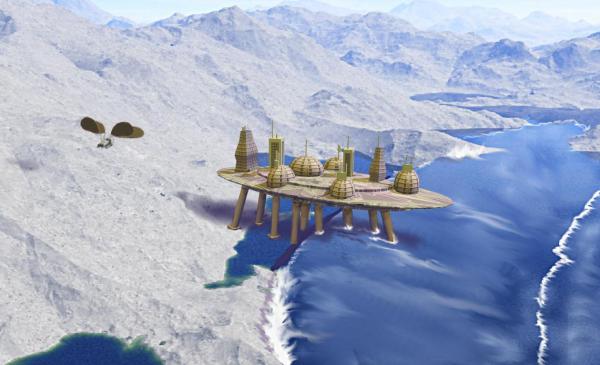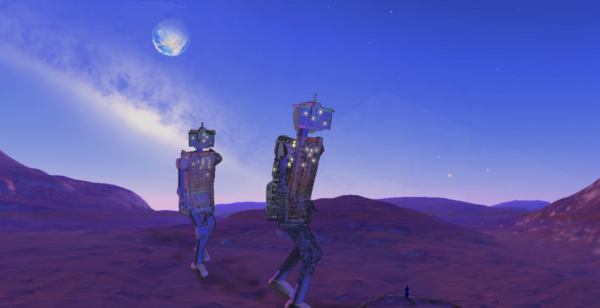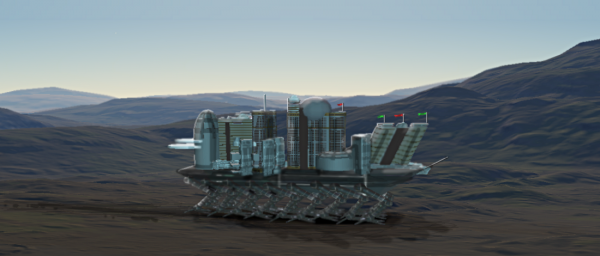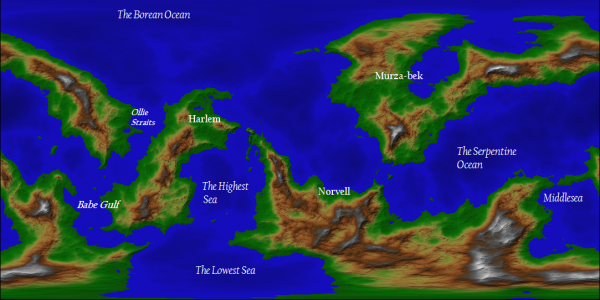BY LETTER
Laurel and Hardy
Galactography > Regions of Space > Outer Volumes
Galactography > Other Major Polities, Empires, and Meta-Empires > Sagittarius Transcultural Cooperation
Galactography > Systems and Worlds > Systems & Worlds G - H
Galactography > Systems and Worlds > Systems & Worlds K - L
Galactography > Other Major Polities, Empires, and Meta-Empires > Sagittarius Transcultural Cooperation
Galactography > Systems and Worlds > Systems & Worlds G - H
Galactography > Systems and Worlds > Systems & Worlds K - L
Twin Planets in Scorpius | |
 Image from Steve Bowers | |
| Laurel (front) and Hardy, in this foreshortened image, appear close; in fact they are never less than 100,000km from each other | |
Star JD 440199102-3
Type G9V
Luminosity 0.4 x Sol
Distance from Sol 3210 ly
Near NGC 6383
Sagitarius Transcultural Cooperation
1090 ly from the Tunh Wormhole Colonised 5767 AT
-----------------------------
Planets Laurel and Hardy
Type Dioscuran Gaian
Orbit of Barycentre around JD 440199102-3:
Semimajor Axis 0.63 AU
Orbital period 0.58 standard years
Average separation of Laurel and Hardy 142020 km
Orbital period of Laurel and Hardy around common barycentre 4.33 standard days
-----------------------------
Laurel:
Mass 0.91 x Earth
Diameter 12390 km
Surface gravity 0.97 gees
Day Length 3.25 standard days
-----------------------------
Hardy Mass 1.12 x Earth
Diameter 13150 km
Surface Gravity 1.06 gees
Day Length 2.16 standard days
---------------------------------------------
This system was reached by the Sagittarius Transcultural Cooperation in 5767AT, during the Age of Re-evaluation.
Laurel and Hardy are examples of young Dioscuran (Twin) worlds, formed from a collision late in the evolution of their system 1,1 billion years ago. Neither planet has had time to become tidally locked to the other, although the lighter Laurel is closer to tidal lock than its partner. Tidal friction is slowing the worlds gradually and both will be locked together before another billion years has passed. Both worlds are notable for the presence of long, thin, mountainous continental landmasses formed along plate boundaries.
The two worlds were both suitable for terraformation, despite extreme tides on these worlds which cause not only a high tidal range but also high volcanic activity. To safeguard against earthquakes most habitation is carried on numerous active stilts or legs which can rapidly react to earth movements. In addition these structures carry mass damping equipment, large dense masses under active control which compensate for shocks, oscillations and other movements.
--------------------------------------------
 Image from Steve Bowers | |
| A walking town gingerly steps over a tsunami on Hardy | |
-------------------------------------------
 Image from Steve Bowers | |
| Walking condos on Laurel | |
-------------------------------------------
 Image from Steve Bowers | |
| Landrunners on Hardy | |
On both worlds a notable phenomenon is the formation of temporary conglomerations of mobile cities; certain favoured locations are often the site of large gatherings of mobile habitats, walking cities and humanoid condos, which link together to form larger cities with shared facilities. These locations tend to be as far removed from earthquake zones and flood risks as possible.
Temporary transport links are established within the conglomerate city, and temporary public spaces and stadia are constructed for sports and entertainment events. These gatherings are also an opportunity for the exchange of goods and services and ideas, and an opportunity for citizens to meet each other in the flesh who have hitherto only interacted via various virtual channels. Some congloms become a rolling party-zone that continues until the habitats stagger away weeks later
------------------------------------------
Danny-le-Ville
 Image from Steve Bowers | |
| Danny's flags convey a subtle code known only to millions of his former guests. | |
Maps of Laurel and Hardy
Laurel
 Image from Steve Bowers |
----------------
Hardy
 Image from Steve Bowers |
Related Articles
Appears in Topics
Development Notes
Text by Steve Bowers
Initially published on 22 June 2014.
Initially published on 22 June 2014.






